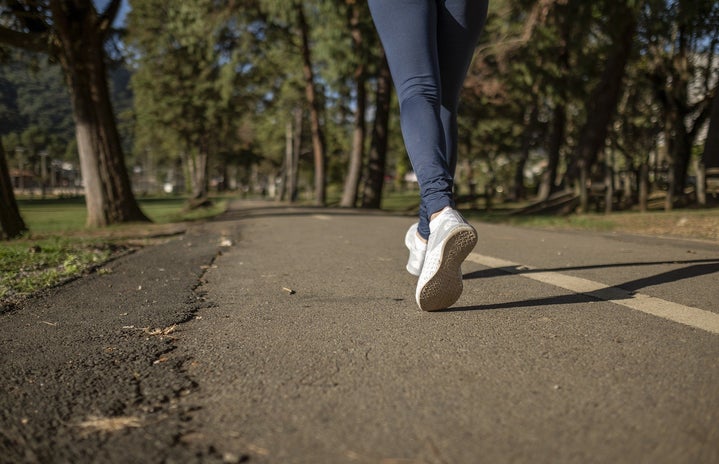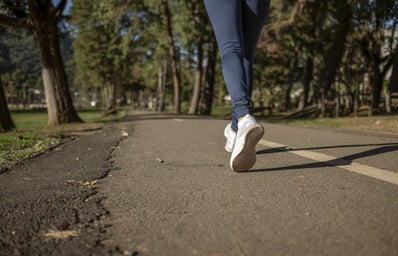A month ago I trained more than six times a week as a Division I athlete. I dashed across campus to get from Peterson to Engineering in under 5 minutes on my Fridays. But the stay-at-home order here in Virginia, and across the world, has left me without my cherished gyms and walks to the Globe. It has separated me from the friends that got me through every hard lift or late night gym sesh. I don’t climb the stairs in David King Hall to get to my microbiology lab or routinely hit 20,000 steps a day.
Thanks, novel coronavirus.
So now, at home, I feel confined. I’m happy to give up comfort for the safety of others, and I understand that for many individuals right now a workout is the last priority. That point aside, staying physically fit is achievable for many even under these conditions. With the privileges I have taken into consideration, I feel sad that I’m not giving my body the exercise it needs, and up until recently, thrived on without lapse. I struggle to get up and move through the day. I forget how much I love to exercise and that Netflix is not going to rival exercise-induced endorphins.
If you’re there too, and the motivation seems hard to find, then, here’s the plan:
1. Set realistic goals
First off, this is a global crisis! Goals don’t have to be lofty to be effective. Here are some of mine:
-
Stay hydrated by refilling your water bottle whenever it’s empty.
-
Workout once a day, even if it’s just the physical labor of gardening.
-
Check-in on your posture when you’re working.
-
Move while listening to lectures.
Your first goal can just be that you’ll start. Once you do that, it’ll be easier to set out on a more detailed plan.
2. Build routine
Time doesn’t exist right now, I know. But wake up and go to sleep at the same time. Every. Single. Day. Shower and dress in fresh clothes. Put on athletic gear and sneakers on your workout days. Eat meals at normal intervals. If available, choose to work in the morning, afternoon, or night, and use the other times to socialize and relax.
3. Prioritize regular breaks
The switch to online work and class means far more screen time than most of us are accustomed to. For me, that means bad posture, tired eyes, and a confused circadian rhythm. I’ll feel nauseous for no reason but the bright light. I forget when I even started to do work. It’s not good for me, and it’s likely not good for you. So, choose a time interval, set a timer, and when that timer rings get up and take a five-minute break of screen-free time. Stretch between lectures. Go get water. Grab a healthy snack. Take a walk outside. Do something that makes you feel alive.
4. Stretch and recover
As mentioned above, my back is suffering for all the wrong reasons. You should stretch often, but at least build it into your routine when you wake up and when you go to sleep. Do it as your coffee brews if that will help you remember.
5. Be creative
I don’t have much workout equipment here at home. I have a few dumbbells, ankle weights, a yoga mat, and an ab roller. Most people have fewer options than even that, which means looking for alternatives. You can use cans or jugs as weights, stack books and utilize chairs in place of step blocks and weight benches, and most importantly, look to the best tool in your disposal: body weight. Need somewhere to start? Arnold Schwarzenegger shared a no-gym workout plan here on Reddit.
6. Get outdoors (if you safely can)
The stay-at-home order here in Virginia makes an exception for exercise when social distancing is abided. If available to you, walk, run, jog, skate, hike, and bike your way to fitness. In addition, the National Park Service still has parks open. Spring is here and the scenery counteracts the screen time we’re all facing. Evenings are a wonderful time to stroll in the fresh air. That being said, do not go outside to exercise if you are in a crowded space or would be utilizing public equipment. Be smart and listen to the advice of public health officials.
7. Find an accountability partner
It can be an Instagramer you follow who shares live workouts, a friend, or a group. Encourage a family member you’re quarantined with to get moving. Start new habits or keep old habits, either way, it’s hard to do it alone.
8. Take advantage of free workout programs
Many personal trainers are offering free workout programs during the crisis. I personally love a relaxing yoga sequence to break up my day, especially because yoga can be done in a small amount of space. My favorite channel for this is yoginimelbourne.
9. Track your progress
Your accountability partner very well could be a journal or spreadsheet. Remember your goals and see how it goes week by week. All this free time allows you to focus on the healthy habits you want to see for yourself.
This pandemic represents a very real challenge to our society and its values. It’s going to test us collectively and individually. Think: what’s your character? In my view, this time is an opportunity to strengthen my willpower and take close notice of what helps or hurts my mental and physical health. It’s a time to remember that I am strong.
And you’re strong too. Please take care of yourself.


